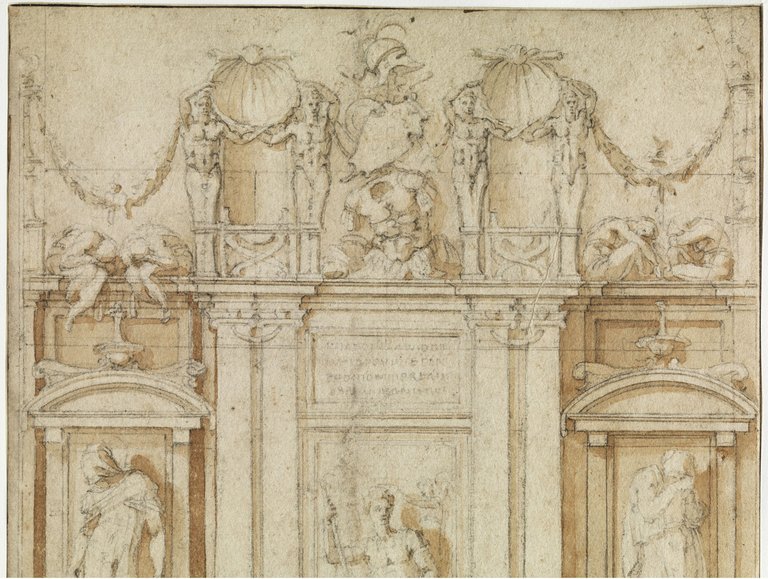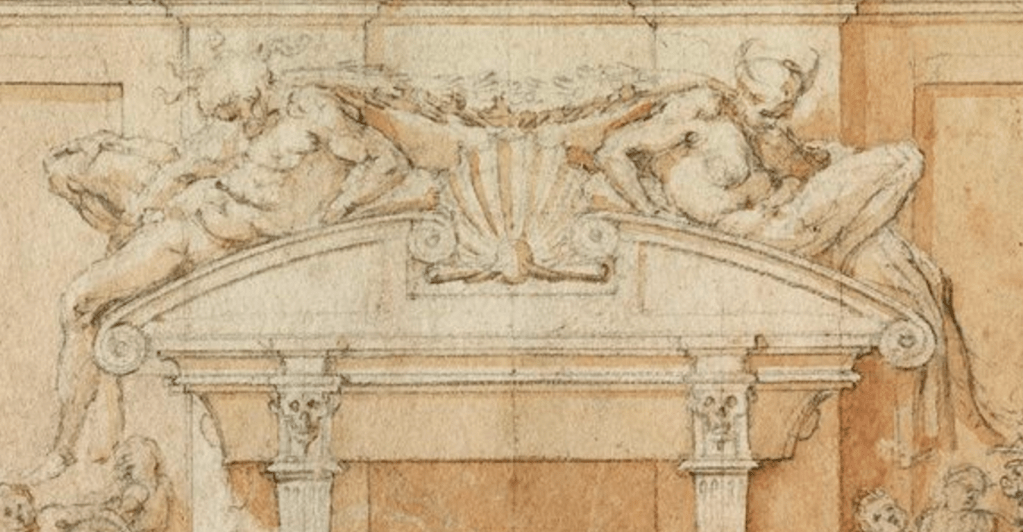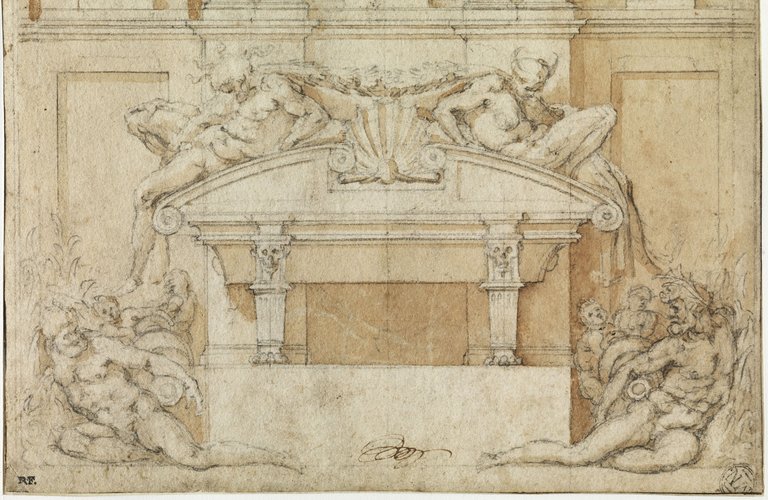Attributed to Michelangelo, Study for one of the Medici tombs at San Lorenzo, 1524. Musée du Louvre, Paris.
Gesamtkunstwerk. It’s the word that Wagner used in 1849 to describe his ideal art form, with all genres of art working together through theatre. Of course it applies specifically to opera, which involves music, drama, and visual design, which in itself includes painting, sculpture and architecture. But gesamtkunstwerke have existed ever since… well, ever since anybody ever built any environment in which people would gather. A church, for example, has architecture, sculpture, painting and music. And, of course, drama. Birth, death, and resurrection – what could be more dramatic than that? And then, of course, there’s the liturgy. However, there are relatively few artists who were talented enough to create ‘a’ Gesamtkunstwerk on their own, although some, like Michelangelo, were nearly there. He was only really held up by external circumstances. Throughout much of his life he wanted to be known as a sculptor, but he is equally well known for his painting. And as you will know by now – especially if you joined me for the talk this week (thank you!) – he also wrote some rich and complex poetry, and was a great correspondent. As he became more successful, he also became an architect – the subject of the fourth and final talk in my series Almost All of Michelangelo. But of course, being Michelangelo, it’s so much more than just putting up walls. He sculpts with light and space, he creates theatres of public drama, and he even manipulates the way in which we move through the environment. No time to talk about all of that today, so I do hope you can join me on Monday 26 September from 5.30-7.30pm. Today, I just want to talk about one drawing of one element of one of his Gesamtkunstwerke, the Medici Chapel in San Lorenzo.

This is one of the drawings I didn’t include in the talk this week, having deliberately omitted anything architectural as otherwise there would have been too much to look at. It should be said that not everyone believes this drawing to be by Michelangelo himself, although Carmen Bambach, a curator at the Metropolitan Museum of Art, and curator and author of the catalogue of the exhibition Michelangelo: Divine Draftsman and Designer, which I mentioned, does. And that’s good enough for me. For those of you familiar with Florence, or Michelangelo, you will instantly recognise one of the Medici tombs from the New Sacristy of San Lorenzo, although this is not how the tomb was finally executed. As work progressed on the chapel Michelangelo gradually simplified his ideas, in part because, stylistically, he was moving towards a greater simplicity, and in part because it was proving impossible to get everything done. As executed, we have the architectural structure from this drawing, including the sarcophagus, plus three sculptures: the figure seated in the central bay (a ‘unit’ of architecture) and the two figures reclining on the casket.

If we start with the top half of the drawing, we can see that it is a highly refined image, drawn in black chalk with a brown wash to give the forms volume and to create a sense of ‘atmosphere’ that is more than diagrammatic. It is clearly a highly finished drawing, with few pentimenti (changes). The only hints of ‘planning’ are the vertical and horizontal lines which are ruled in different places across the image, as well as a very faint circle which would define the lunette of the wall above the monument – although that is all but cut off at the top (the circle is most visible on the right). This is clearly a drawing by someone who has made up their mind exactly what they want, and wants to communicate that to someone else: the patron or his agent, in this case Cardinal Giulio de’ Medici, who by this time was Pope Clement VII. I will tell you more about the chapel itself, and its history – both as planned and as executed – on Monday. Today I just want to look at this drawing.
The architectural structure of the tomb is three bays wide, two narrow bays flanking a wider, central bay. The bays are separated by paired pilasters, with slightly taller and simpler pilasters at far left and right. The rhythm of the tomb – narrow, wide, narrow – is not unlike that of a triumphal arch, and inevitably the implication would be that the soul of the deceased will triumph over death because of their Christian faith. The two outer bays contain niches framed by tabernacles – like a temple front but with only one ‘opening’ – topped by segmental pediments (i.e. a segment of a circle). In each we see the top half of a standing figure. The central bay is less shadowy, which implies that it is further forward, and also that it doesn’t have any sculptural framing elements, like the two tabernacles, to contain the seated figure, of which here we can only see the head and shoulders.
The four pilasters support a cornice, which itself supports elaborate decoration, none which was executed (with the exception, perhaps, of one of the crouching figures – I’ll show you that on Monday). Above the outer bays are pairs of seated figures – their legs dangling over the cornice to the left, and tucked up on the right. The paired pilasters support narrow balustrades, the balusters being placed further apart than the combined width of the pilasters, making these units look a bit top heavy, almost like a sense of growth as we go upwards. There is a herm – a flaring column which develops into the torso of a person – standing on each of the balusters, and each pair of herms holds a scallop shell. Garlands hang from the outer herms, looping up again towards the edges of the monument, where each is supported by a candelabrum. In the centre are trophies of war – an empty suit of armour, topped by shields, with a helmet at the very top.

It is the lower part of the monument with which we are more familiar. Not only does it have the most identifiable sculptures – and ones which were actually executed – but also, when we are in the chapel, this is the section at eye-level. Certainly in this detail we can ‘recognise’ the two figures slumped across the sarcophagus, even though there were not finished in exactly this form. But they do have the extreme articulation which is typical of Michelangelo’s ‘early mature’ style, an extreme exaggeration of contrapposto whereby one leg is as bent as it can be, while the other, if not exactly straight – and certainly not ‘weight bearing’ in this context – is at least stretched out. Both figures also twist through the torso, with one arm bent, and the other more elongated. A clue to their identities is given by details sketched around the heads. On the left, the bearded figure has at least four wavy forms radiating around his hair, while the figure on the right has two curving horns. These represent the sun and a crescent moon – unusually diagrammatic elements of symbolism for Michelangelo, which is probably why he simplified the figures and carved Day and Night without them. These figures refer to the passing of time, which is, in itself, a memento mori – a reminder of death – an idea made explicit by the two skulls carved on the capitals of the pilasters which support the sarcophagus.

Seen in the context of the lower half of the tomb, the figures of Day and Night still look familiar – but you’ll know if you’ve seen them in person that there is nothing lying on the floor. Reclining on one arm with both legs stretched out, these characters have circular objects tucked under their arms. These are jugs, and the reclining pair represent river gods – we saw the river Eridanus, who ‘received’ Phaeton as he plummeted to his death, in last week’s blog. Michelangelo did get as far as planning these sculptures. There are drawings of them, and he even made a full-sized model for one of them which is now in the Casa Buonarroti in Florence.

Modelled in terracotta, Michelangelo could have handed this over to an assistant to carve, but chose not to, preferring the bold simplicity which the chapel has now. It’s a remarkable sculpture, but not the most flattering image of a god. Rather than the bold, broadly muscular classical figures he arranged on the Capitoline Hill – one of his great architectural projects which is effectively small-scale town planning – this figure looks somewhat emaciated, with admittedly muscular, but wiry legs, and too much skin, but not enough muscle, around the midriff. It has to be said that the current ‘simplicity’ of the chapel was not just an artistic choice. He left Florence in 1534 never to return, and the chapel was put together by assistants following Michelangelo’s instructions which were posted from Rome, a correspondence course in architecture.

Had the River Gods been included there would have been a strong pyramidal structure, with the seated figure – a portrayal, though not a portrait, of Giuliano de Medici, Duke of Nemours – at the top centre. Notice how the feet of the river gods lie in front of the base of the tomb. Not only would they have been further out to the left and right, but they would also have been further forward, encroaching onto the floor space of the chapel (another potential reason why they were omitted). Day and Night are further back and further in, with Giuliano further back again. The sculpture recedes in space towards the middle of the wall. So although the architecture seems to push forward, the sculpture pulls back, a tension typical in Michelangelo’s work as a whole. This also creates areas of light and shade, with the side niches, the rivers, and the sarcophagus creating the darkest shadows, leaving Giuliano in the light – so as well as being at the apex of the pyramid he is also the most brilliantly illuminated. This is what I mean by sculpting in light – and I’ll talk more about this, and other ways in which Michelangelo achieved it, on Monday.
When I was talking about Michelangelo’s drawings this week, I started with the earliest, which were drawn from frescoes by Giotto and Masaccio. As a young man he learnt from the Masters, and the most sculptural painters at that. Inevitably later artists learnt from him in the same way. How do we know that? Well, apart from the obvious visual influence in their art, there are other drawings which suggest as much. As well as today’s drawing of Giuliano’s tomb by Michelangelo himself, the Louvre also has a drawing by Federico Zuccaro of the opposite tomb – of Lorenzo, Duke of Urbino – as it was executed. If you thought it was busy the last time you visited, that’s not entirely new. Look at what it was like in 1580. These are all artists drawing (plus a dog). I don’t think you’d get away with clambering over the architecture nowadays.


Your, Almost all of Michelangelo lectures, were all riveting. Thank you. Sadly might miss Winslow Homer as looking after my grandson. Lucilla
>
LikeLike
Thank you, Luciilla! Sorry that you might miss Homer, but enjoy your time with your grandson!
LikeLike